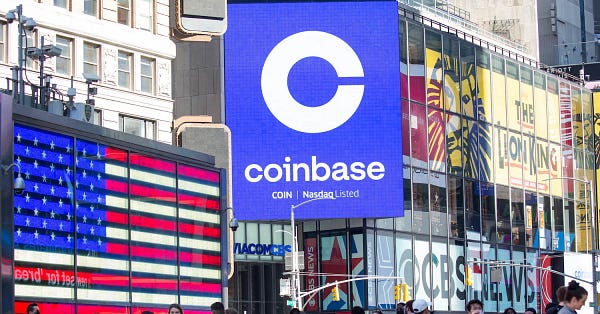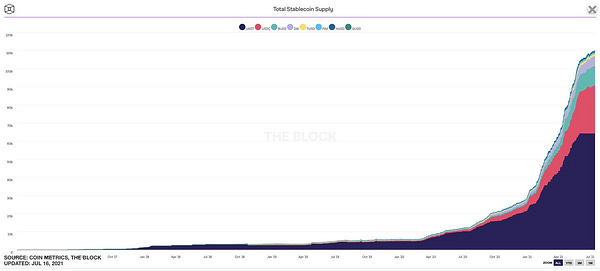Stablecoins and the New High-Interest Savings Account
Goodnight, Banks

Before getting into the meat and potatoes of this edition of the newsletter, I wanted to share a recent Tweet that I found to be an interesting follow up to what I wrote in the last edition of the newsletter about the IMF and the World Bank.


I wrote about the economic philosophy of William Easterly, former senior World Bank economist and current NYU professor, in an earlier edition of the newsletter. He wrote a book entitled The White Man’s Burden: Why the West’s Efforts to Aid the Rest Have Done So Much Ill and So Little Good that I highly recommend. In the book and in the article linked above, we learn about how the IMF and the World Bank have worsened poverty in developing countries. So, when these institutions want to hinder the rolling out of a bitcoin ecosystem in El Salvador, please know it has little to nothing to do with whether or not bitcoin will work as a currency, and much more to do with abusive institutions losing their grasp on power.
Also, if you’d like to read more about what I wrote about Nancy and Paul Pelosi’s insider trading, I highly recommend this piece by Intercept staff writer, Glenn Greenwald on the topic. Greenwald discusses how Nancy regulates the companies, and how Paul cashes in by correctly betting on the direction in which these companies’ stock prices will move. Nancy and Paul make Warren Buffett and Charlie Munger look like amateurs. Or maybe it’s more apt to say that they make Bonnie and Clyde look like amateurs, but I’ll wait until we actually enter the next Great Depression before I go there.
And now, back to our regularly scheduled programming…
Stablecoins and the New High Interest Savings Account
Remember when you could deposit money in a savings account at your local bank and that money would grow at about 4-5% APY risk free? Ah, the good old days. The days when the Fed lent money to commercial banks at that same 4-5% (and when college students could borrow money for school at 1-2%, as opposed to the current 7-11%). But those days are long gone, my friends. Now, the Fed lends commercial banks money at 0% interest, your dollars are losing 1-2% of their value per month, and bonds are about produce a negative yield. Truly incredible what a circus the Fed in conjunction with the U.S. government has created. And for this reason, we say, “Thank you Sweet Baby Jesus for cryptocurrency.” However, today, I am not here to wax poetic about the virtues of crytocurrencies like bitcoin or ether. No, ma’am. Today, I’m here to discuss “stablecoins” and their increasingly important (and controversial) role in both digital asset and legacy financial systems.
So, let’s first start with the following question: What is a stablecoin? A stablecoin is a digital token “whose value is pegged to another asset class, such as fiat currency or gold, to stabilize its price.” The main difference between an asset like bitcoin and a stablecoin is that stablecoins do not (or barely) fluctuate in price. I like to think of them as synthetic dollars. Stablecoins have value because of the underlying asset or basket of assets that give them value. The assets in that basket are swapped in and out to keep the price of the stablecoins, well, stable. Some like to think of stablecoins as tokenized money market funds.


For a longer explanation on what exactly stablecoins are, feel free to learn more here and here.
Visa is already using stablecoins to settle transactions, because transactions can be settled far more quickly with stablecoins than with dollars. And PayPal now accepts payments with stablecoins. To say that stablecoins are gaining traction is quickly turning into an understatement.
But since stablecoin issuers in the United States are non-banks, the transparency regarding the underlying assets that support the stablecoins can be an issue. Stablecoin USDT, better know as “Tether” has dealt with its share of scrutiny from the New York Attorney General. Luckily, the institution that created Tether proved to the NY AG that they had enough cash reserves to back all of the USDT tokens in circulation. Can all stablecoin issuers say the same? I don’t know.
Avanti Bank founder and CEO, Caitlin Long, has long warned about potential issues with stablecoin backing, and when someone as smart as her speaks up, I listen. I recommend starting with the thread below.


She also recently shared her 10 stablecoin predictions and how stablecoins will impact monetary policy with the Cato Institute. Truly fascinating to learn more about if you have the time to read the very-detailed linked piece. Also, I have listened to the episode of the podcast below just yet, but judging by the all of podcast episodes that have featured Caitlin Long as a guest that I have listened to, my bet would be that the below episode is worth checking out.


Lastly, before I get into how stablecoins can positively impact your personal finances, I also recommend checking out this piece on stablecoins: “A New Global Monetary Order Threatens the Dollar”, by Jim Bianco at Bloomberg. It’s fascinating to read about how, historically speaking, we have reached the end of the current monetary order and how stablecoins built on DeFi networks are likely the beginning of the new dominant monetary order.
Anyway, you’re probably thinking, “Frank, stop hurting my brain with all of this technical and policy-oriented mumbo jumbo and just tell me why I should care.” Well, you should care for a number of reasons, but I won’t outline all of those here. The main reason that I will focus on is that there is money to be made simply on holding stablecoins. Currently, you can earn 7.4% APY on your Gemini Dollars (a stablecoin created by Gemini).


Soon, you’ll be able to earn 4% APY on your $USDC (USD Coin) with Coinbase.


On Voyager, you can earn 9% of your $USDC. But if you live in the incredibly dumb state of New York, you can’t use platforms like Voyager.
If you want to dive into less-centralized waters, you can follow someone like crypto influencer Lark Davis and earn up to 19.5% APY on your UST (TerraUSD).

Pretty wild numbers compared to the 0.5% APY Ally Bank is offering you on your high-interest savings account, no?
So, if the volatility of holding assets like bitcoin or ether is too much for you, consider taking a more stable approach (terrible, I know) and earning a yield on your stablecoins, your synthetic dollars. But also keep in mind that not all stablecoins may be created equal and that certain stablecoins have proven to be backed by proper and sufficient underlying assets, while others may not be. Personally, I trust $USDC (USD Coin) the most. Here’s a great piece from its founders at Circle if you are interested.
As always, I am not a financial advisor and nothing in this edition of the newsletter is financial advice, so please do your own research and make your own decisions.
Best,
Frank
Twitter: @frankcorva
Currently Watching/Listen To:





Nice read 👍 Thanks, Frank!